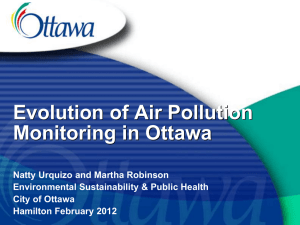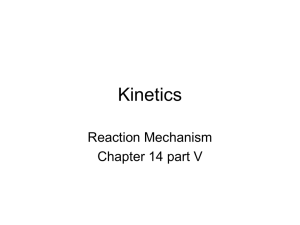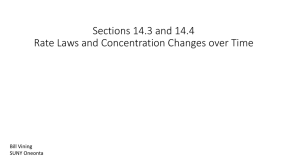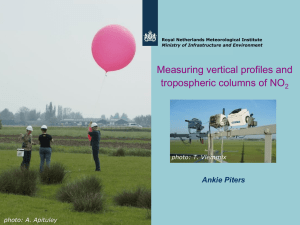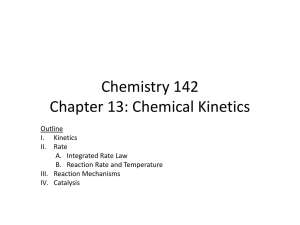b - Gordon State College
advertisement
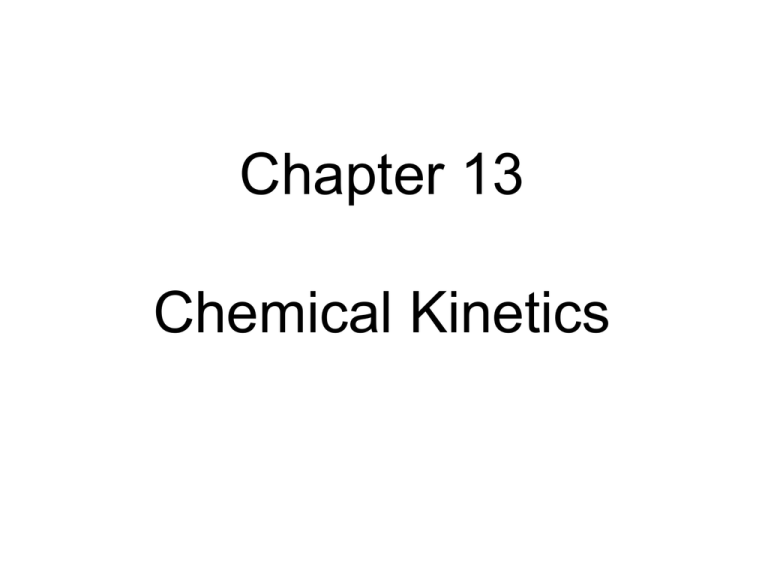
Chapter 13 Chemical Kinetics The study of reaction rate is called chemical kinetics. Reaction rate is measured by the change of concentration (molarity) of reactants or products per unit time. Molarity of A: [A], e.g. [NO2]: molarity of NO2 r− reactantf reactanti t f ti Δreactant − Δt reactants products, [reactant]↓ and [product]↑ OR r productf producti t f ti Δproduct Δt Unit: mol·L−1·s−1 ≡ M·s−1 2NO2 (g) 2NO (g) + O2 (g) − = r(NO2) rate is a function of time 0 s → 50 s: r NO2 NO2 0.0079 M 0.0100 M 4.2 10-5 M s1 t 50 s 0 s 50 s → 100 s: r NO2 NO2 0.0065 M 0.0079 M 2.8 10-5 M s 1 t 100 s 50 s 2NO2 (g) 2NO (g) + O2 (g) − = r(NO2) − rate is a function of time 50 s → 100 s: NO 0.0035 M 0.0021 M r NO 2.8 10-5 M s 1 t 100 s 50 s 50 s → 100 s: r O2 O2 0.0018 M 0.0011 M 1.4 10-5 M s 1 t 100 s 50 s 2NO2(g) 2NO(g) + O2(g) n NO 2 Δ[NO2 ] Δ V Δn NO 2 2 r(NO2 ) Δ[NO2 ] Δt Δ[O2 ] r(O2 ) Δ[O2 ] ΔnO2 1 n O2 Δ Δt V aA+bBcC+dD r(A) a r(B) b r(A) r(B) , a b r(A) a r(C) c r(A) r(C) a c r(A) r(B) r(C) r(D) r= a b c d r does not depend upon the choice of species 2N2O5(g) 4NO2(g) + O2(g) r(N2O5) = 4.2 x 10−7 M·s−1 What are the rates of appearance of NO2 and O2 ? Example 13.1. page 567 Consider the following balanced chemical equation: H2O2(aq) + 3 I–(aq) + 2 H+(aq) I3–(aq) + 2 H2O(l) In the first 10.0 seconds of the reaction, the concentration of I– dropped from 1.000 M to 0.868 M. (a)Calculate the average rate of this reaction in this time interval. (b) Predict the rate of change in the concentration of H+ (that is, [H+]/t) during this time interval. Consider the general reaction aA + bB cC and the following average rate data over some time period Δt: Δ[A] 0.0080 M s 1 Δt Δ[B] 0.0120 M s 1 Δt Δ[C] 0.0160 M s1 Δt Determine a set of possible coefficients to balance this general reaction. − = r(NO2) − All the rates in this table are average rates. 2:00 pm 2:16 pm Δt 3:16 pm Δl 0 mile Barnesville 16 miles Griffin 56 miles Atlanta Average Speed from B to G = 16 miles ÷ 16 min = 1.0 mile/min Average Speed from G to A = 40 miles ÷ 60 min = 0.7 mile/min l d l Instantaneous speed at green spot lim t 0 t dt Instantaneous speed contains more information l Atlanta 56 miles Δl Griffin 20 miles Barnesville 0 mile 0 min Δt 16 min t 76 min Instantaneous speed at the red point = slope of the red solid line = l t Reaction rate is a function of time Factors that affect reaction rates State of the reactants Concentrations of the reactants Temperature Catalyst aA+bBcC+dD r=k [A]m [B]n 1 Δ[A] 1 d[A] a Δt a dt Differential rate law: how r depends on concentrations m, n: reaction order, mth order for A, nth order for B (m+n): overall reaction order k: rate constant: depends on temperature, but not concentrations m and n must be measured from experiments. They can be different from the stoichiometry. (1) 2N2O5(g) 4NO2(g) + O2(g) (2) CHCl3(g) + Cl2(g) CCl4(g) + HCl(g) (3) H2(g) + I2(g) 2HI(g) r = k[N2O5] r = k[H2][I2] r = k[CHCl3][Cl2]1/2 aA + bB cC +dD r = k [A]m [B]n Units overall reaction order (m+n) ⇌ unit of k (1) 2N2O5(g) 4NO2(g) + O2(g) (2) CHCl3(g) + Cl2(g) CCl4(g) + HCl(g) (3) H2(g) + I2(g) 2HI(g) r = k[N2O5] r = k[H2][I2] r = k[CHCl3][Cl2]1/2 How to find the rate law by experiment: method of initial rates NH4+ (aq) + NO2− (aq) N2(g) + 2H2O(l) Experiment Number Initial [NH4+] (M) Initial [NO2−] (M) Initial Rate (M·s−1) 1 0.100 0.0050 1.35 x 10−7 2 0.100 0.010 2.70 x 10−7 3 0.200 0.010 5.40 x 10−7 r = k [NH4+]m [NO2−]n A very common method to investigate how each factor affects the whole system: Change one thing at a time while keep the others constant. z = f (x,y) z z How does the change of x affect z? x y x z z How does the change of y affect z? y x y How to find the rate law by experiment: method of initial rates NH4+ (aq) + NO2− (aq) N2(g) + 2H2O(l) Experiment Number Initial [NH4+] (M) Initial [NO2−] (M) Initial Rate (M·s−1) 1 0.100 0.0050 1.35 x 10−7 2 0.100 0.010 2.70 x 10−7 3 0.200 0.010 5.40 x 10−7 r = k [NH4+]m [NO2−]n 2NO(g) + 2H2(g) N2(g) + 2H2O(g) Experiment Number Initial [NO] (M) Initial [H2] (M) Initial Rate (M·s−1) 1 0.10 0.10 1.23 x 10-3 2 0.10 0.20 2.46 x 10-3 3 0.20 0.10 4.92 x 10-3 (a) Determine the differential rate law (b) Calculate the rate constant (c) Calculate the rate when [NO] = 0.050 M and [H2] = 0.150 M 2NO(g) + 2H2(g) N2(g) + 2H2O(g) again Experiment Number Initial [NO] (M) Initial [H2] (M) Initial Rate (M·s−1) 1 0.10 0.10 1.23 x 10-3 2 0.10 0.30 3.69 x 10-3 3 0.30 0.10 1.11 x 10-2 (a) Determine the differential rate law (b) Calculate the rate constant (c) Calculate the rate when [NO] = 0.050 M and [H2] = 0.150 M A+BC Experiment Number Initial [A] (M) Initial [B] (M) Initial Rate (M·s−1) 1 0.100 0.100 4.0 x 10−5 2 0.100 0.200 4.0 x 10−5 3 0.200 0.100 1.6 x 10−4 (a) Determine the differential rate law (b) Calculate the rate constant (c) Calculate the rate when [A] = 0.050 M and [B] = 0.100 M EXAMPLE 13.2 Determining the Order and Rate Constant of a Reaction NO2(g) + CO(g) NO(g) + CO2(g) From the data, determine: (a) the rate law for the reaction (b) the rate constant (k) for the reaction Use the data in table to determine 1) The orders for all three reactants 2) The overall reaction order 3) The value of the rate constant r = k [BrO3−]m [Br−]n [H+]p r1 = k (0.10 M)m (0.10 M)n (0.10 M)p = 8.0 x 10−4 M · s−1 r2 = k (0.20 M)m (0.10 M)n (0.10 M)p = 1.6 x 10−3 M · s−1 r3 = k (0.20 M)m (0.20 M)n (0.10 M)p = 3.2 x 10−3 M · s−1 r4 = k (0.10 M)m (0.10 M)n (0.20 M)p = 3.2 x 10−3 M · s−1 one quiz after lab Relationship among reaction rates as expressed by different species. r(A) r(B) r(C) r(D) r= a b c d overall reaction order (m+n) ⇌ unit of k Method of initial rates: table of experimental data rate order, k, rate at other concentrations. aA+bBcC+dD r = k [A]m [B]n Differential rate law: how r depends on concentrations Differential rate law: differential equation [ A] d [ A] r k [ A]m [ B]n at a dt How concentration changes as a function of time integrated rate law A Products First order reaction differential rate law: Δ[A] d[A] r = r(A) k[A] Δt dt First order reaction integrated rate law: ln[A] kt ln[A]0 or [A]0 ln kt [A] integrated rate law: how concentration changes as a function of time. First order reaction integrated rate law: ln[A] kt ln[A]0 [A] is the molarity of A at t y = mx + b Plot ln[A] vs. t gives a straight line Slope = −k, intercept = ln[A]0 N2O5(g) 2NO2(g) + ½ O2(g) [N2O5] (M) Time (s) 0.1000 0.0707 0.0500 0.0250 0 50 100 200 0.0125 0.00625 300 400 Use these data, verify that the rate law is first order in N2O5, and calculate the rate constant. k = 6.93 x 10−3 s−1 Read a similar Example 13.3 on page 575 Using the data given in the previous example, calculate [N2O5] at 150 s after the start of the reaction. [N2O5] (M) Time (s) 0.1000 0 0.0707 50 0.0500 100 0.0250 200 0.0125 300 0.00625 400 0.0354 M Practice on Example 13.4 on page 576 and check your answer The half-life of a reaction, t1/2, is the time required for a reactant to reach one-half of its initial concentration. [N2O5] (M) Time (s) 0.1000 0 0.0707 50 0.0500 100 0.0250 200 0.0125 300 0.00625 400 The half-life for first order reaction: t1 / 2 ln 2 k The half-life for first order reaction does NOT depend on concentration. [N2O5] (M) Time (s) 0.1000 0 0.0707 50 0.0500 100 0.0250 200 0.0125 300 0.00625 400 A Plot of [N2O5] versus Time for the Decomposition Reaction of N2O5 [N2O5 ] [N2O5 ]0 ekt A certain first order reaction has a half-life of 20.0 s. a)Calculate the rate constant for this reaction. b)How much time is required for this reaction to be 75 % complete? t1 / 2 ln 2 k a) k = 0.0347 s−1 [A]0 ln kt [A] b) k = 40.0 s Try Example 13.6 and For Practice 13.6 on page 579 and check your answers A Products Second order reaction differential rate law: Δ[A] d[A] r(A) k[A] 2 Δt dt Second order reaction integrated rate law: 1 1 kt [A] [A]0 integrated rate law: how concentration changes as a function of time. Second order reaction integrated rate law: 1 1 kt [A] [A]0 y = mx + b Plot 1/[A] vs. t gives a straight line Slope = k, intercept = 1/[A]0 The half-life for second order reaction: t1/ 2 1 k [A]0 The half-life for second order reaction depends on initial concentration. A certain reaction has the following general form: A B At a particular temperature [A]0 = 2.80 x 10−3 M, concentration versus time data were collected for this reaction, and a plot of 1/[A] versus time resulted in a straight line with a slope value of 3.60 x 10−2 M−1·s−1 a)Determine the (differential) rate law, the integrated rate law, and the value of the rate constant. b) Calculate the half-life for this reaction. c) How much time is required for the concentration of A to decrease to 7.00 x 10−4 M ? 1 1 kt [A] [A]0 t1/ 2 1 k [A]0 (show your work, do not copy the question) For first order reaction, show that t1 / 2 ln 2 k from the integrated rate law ln[A] kt ln[A]0 A Products Zero order reaction differential rate law: Δ[A] d[A] r(A) k[A] 0 k Δt dt Zero order reaction integrated rate law: [A] kt [A]0 integrated rate law: how concentration changes as a function of time. Zero order reaction integrated rate law: [A] kt [A]0 y = mx + b Plot [A] vs. t gives a straight line Slope = −k, intercept = [A]0 The half-life for zero order reaction: t1/ 2 [ A ]0 2k The half-life for zero order reaction depends on initial concentration. The Decomposition Reaction 2N2O(g) 2N2 (g) + O2 (g) takes place on a Platinum Surface The decomposition of ethanol on alumina surface C2H5OH(g) C2H4(g) + H2O(g) was studied at 600 K. Concentration versus time data were collected for this reaction, and a plot of [C2H5OH] versus time resulted in a straight line with a slope value of −4.00 x 10−5 M·s−1 a)Determine the (differential) rate law, the integrated rate law, and the value of the rate constant. b) If the initial concentration of C2H5OH was 1.25 x 10−2 M, calculate the half-life of this reaction. c) How much time is required for all the 1.25 x 10−2 M C2H5OH to decompose ? [A] kt [A]0 t1/ 2 [ A ]0 2k Factors that affect reaction rates State of the reactants Concentrations of the reactants Temperature Catalyst aA + bB cC +dD r = k [A]m [B]n k: rate constant: depends on temperature, but not concentrations A Plot Showing the Exponential Dependence of the Rate Constant on Absolute Temperature Collision model: molecules must collide to react. Not all collisions lead to products T ↑ v ↑ kinetic energy = ½ mv2 ↑ activation energy Prentice Hall © 2003 Chapter 14 Fraction of molecules whose Ek > Ea is T↑f↑ f e Ea ↑ f ↓ Ea / RT k zf ze Ea / RT k kexpt Another factor needs to be taken into account molecular orientation Several Possible Orientations for a Collision Between Two BrNO Molecules BrNO + BrNO 2NO +Br2 Ea / RT k pze steric factor p ≤ 1 Arrhenius equation Ea / RT k Ae A: frequency factor T↑k↑ How k depends on T Ea ↑ k ↓ k1 Ea 1 1 ln k2 R T1 T2 At 550 °C the rate constant for CH4(g) + 2S2(g) CS2(g) + 2H2S(g) is 1.1 M·s−1, and at 625 °C the rate constant is 6.4 M·s−1. Using these value, calculate Ea for this reaction. k1 Ea 1 1 ln k2 R T1 T2 Ea = 1.4 x 105 J/mol Try Example 13.8 on page 585 and check your answers h The ball can climb over the hill only if its kinetic energy is greater than Ep = mgh, where m is the mass of the ball, h is the height of the hill, and g is gravitational acceleration. (a) The Change in Potential as a Function of Reaction Progress (b) A Molecular Representation of the Reaction BrNO + BrNO 2NO +Br2 O N Br exothermic reaction Reaction Mechanism Chemical Equation Reactants Products NO2 + CO NO + CO2 Step 1: Step 2: NO2 + NO2 NO3 + NO NO3 + CO NO2 + CO2 NO2 + CO NO + CO2 NO3: intermediate, does not appear in overall reaction + NO2 NO2 NO3 NO NO3 CO NO2 CO2 Whole process is called the reaction mechanism. Each single step is called an elementary reaction/step. An elementary reaction is a single collision. For an elementary reaction aA + bB cC + dD r = k[A]a[B]b Not for overall reaction! Overall reaction: r = k[A]m[B]n , find m and n by experiments The number of molecules that react in an elementary reaction is called the molecularity of that that elementary reaction (not applicable to overall reaction). 1 ― unimolecular 2 ― bimolecular 3 ― termolecular What determines the rate of an overall reaction? Team A Team B Slowest step: rate determining step Which step is the rate determining step? 2nd exothermic or endothermic? Ep intermediate Ea, 2 Ea, 1 Reactants ∆E Products Reaction progress Factors that affect reaction rates State of the reactants Concentrations of the reactants Temperature Catalyst Catalyst is a substance that speeds up a reaction without being consumed itself. Catalyst changes the reaction mechanism through a lower activation energy pathway. Energy Plots for a Given Reaction Ea Ea homogeneous catalyst heterogeneous Homogeneous catalyst: same phase as reactants. 3O2(g) 2O3(g) 2NO(g) + O2(g) 2NO2(g) light 2NO2(g) 2NO(g) + 2O(g) 2O2(g) + 2O(g) 2O3(g) + 3O2(g) 2O3(g) NO(g): catalyst; NO2(g), O(g): intermediates Heterogeneous catalyst: different phase from reactants. The Decomposition Reaction 2N2O(g) 2N2 (g) + O2 (g) takes place on a Platinum Surface These Cookies Contain Partially Hydrogenated Vegetable Oil −C−C− − − + H2 − − C=C milk sugar = lactose

